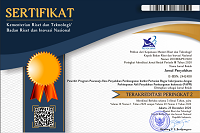Strategi Pengembangan Karier PNS Fungsional Umum di Institut Pertanian Bogor
Abstract
The main issues in the field of human resources is a state civil officials on the quality and distribution of civil servants, therefore we need a research to know the civil servant career development strategy. Process and career development should be professional career development oriented of civil servants which means not only the structural purpose, but also to developing expertise towards functional. Thus, the position of the functional has a role as equal partners in a structural position. The purpose of this study is to identify what are the main priorities of the factors, actors and objectives as well as the recommendation of alternative strategies are most influential on the development of common functional civil servants career in IPB. The research was conducted at IPB and the Bureau of Personnel Culture and Education Ministry Secretariat using descriptive analysis and AHP (Analytical Hierarchy Process) methods. The results of the descriptive analysis is from 1.500 civil servants education personnel only 14,3% certain functional officials in IPB, thus 83,7% is common functional PNS included structural officials which selectively will be converted to be specific functional civil service officials. Results obtained from AHP processing the alternative strategy most recommended is the establishment of assessment centers (0,482) by actor Vice Rector of Resources and Strategic Studies (0,498), through the strengthening of organizational factors (0,357) with the aim of increasing professionalism (0,600), that all are the main priorities which influence to the development of a common functional IPB civil servants career.
Keywords: civil servant quality and distribution, professionalism, carrier development strategy, assesment center
Downloads
Authors who publish with this journal agree to the following terms:
- Authors retain copyright and grant the journal right of first publication with the work simultaneously licensed under a

This work is licensed under a Creative Commons Attribution 4.0 International License that allows others to share the work with an acknowledgement of the work's authorship and initial publication in this journal. - Authors are able to enter into separate, additional contractual arrangements for the non-exclusive distribution of the journal's published version of the work (e.g., post it to an institutional repository or publish it in a book), with an acknowledgement of its initial publication in this journal.
- Authors are permitted and encouraged to post their work online (e.g., in institutional repositories or on their website) prior to and during the submission process, as it can lead to productive exchanges, as well as earlier and greater citation of published work (See The Effect of Open Access).















